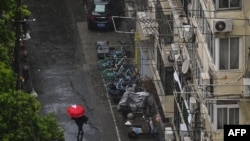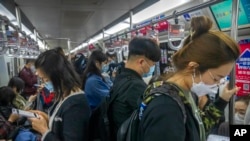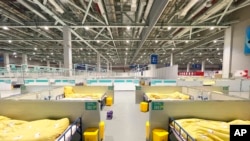Lockdowns of Chinese cities to contain the spread of COVID-19 are snarling imports and exports, according to economists. They say those hitches are slowly raising prices abroad while lowering demand in the world’s largest market for inbound merchandise.
The well-off port city of Shanghai, with a population of about 25 million people, began phasing in lockdowns last month as COVID-19 cases rose on their way to more than 200,000 as of Tuesday. Those restrictions followed the shuttering of China’s tech megalopolis, Shenzhen, in March.
Seaports in both cities have slowed because of a lack of workers and a quarantine on inbound crews of cargo ships from abroad, analysts said. Shanghai is the world’s largest container port and Shenzhen ranks fourth.
At Chinese factories, a backbone of the domestic and world economy, “limited” amounts of labor, plus suspended transportation, mean operators can “only rely on onsite inventory to barely meet the needs of production lines,” Taipei-based market research firm TrendForce said in an April 11 research note emailed to VOA.
All or parts of the local BMW, Tesla and Volkswagen auto factories are temporarily closed in the Shanghai area, media reports from China said.
High prices and supply chain disruptions have followed in COVID-19’s wake around the world over the past two years.
“There are significant concerns that this will add further disruption to global supply chains and to shipping as well,” said Rajiv Biswas, Asia-Pacific chief economist with IHS Markit in Singapore.
The 2020 outbreak in China “brought economic activity to a standstill” and caused that nation’s first-quarter GDP to fall by 6.8%, the U.S.-China Economic and Security Review Commission said. It pointed to a crash in consumer demand and a slowdown in factory work. Global transportation and shipping were “upended,” the report said.
Price increases
China’s second major COVID-19 wave — after the world’s first in early 2020 — has raised prices of Chinese exports sold overseas because of the supply chains, said Jonathan Ravelas, chief market strategist with Banco de Oro UniBank in the Philippines.
Inflation worldwide stands at 3.18%, according to market research firm Statista, well above the 1.5% that central bankers prefer. Previous supply chain hitches are among the reasons.
Consumers in inflation-weary countries such as the Philippines are searching for cheaper merchandise or buying in bulk, Ravelas said. Inflation in the Southeast Asian country stood at 4% in early April, up from 3.6% in 2021.
“Filipinos, from time to time, we get to see high inflation, so I guess this is where the resilience of the Filipino family is there,” Ravelas said. Rice prices surged in 2018, for example, and the Philippine government lowered tariffs to keep prices down. “You’re going to buy products that will fit your budget,” he said.
Higher prices of commodities as well as coal and fuel will ripple around parts of Asia if the Chinese lockdowns persist, Biswas said.
Less consumer demand in China
Back in China, consumers are expected to buy less merchandise altogether for lack of permission to go out, Biswas said.
Sporadic lockdowns that last “some time” could dampen Chinese demand for imports, Biswas said. He said that would mean weaker demand for raw materials and the components for manufactured goods.
Waits at the port in Shanghai have lengthened, he said, and 2021 was already marred by “very long delays.” Industrial production has slowed this year, too, his company has found.
At the Shanghai-based Waigaoqiao port, it takes longer now to find a berth, a spokesperson for the Maersk shipping line said this week. “All warehouse operations have been closed until further notice,” the spokesperson added. “The efficiency of Maersk trucking services from and to Shanghai has been further impacted due to the lockdown.”
Related effects of China’s lockdowns so far this year could take a percentage point off its 2022 economic growth forecasts, said Alicia Garcia Herrero, chief Asia-Pacific economist with the French investment bank Natixis.
“Chinese imports are going to collapse, so the impact on any major exporter into China is going to be very obvious except for commodities,” Garcia said. “Not machinery, not anything that China can actually produce itself, basically. Autos, all of that, is going to be terrible.”
The World Bank forecasts 5.1% economic growth in China this year, down from 8.1% in 2021.
Business travel on hold
Foreign businesspeople headed to China already face two-week hotel quarantines. The city-by-city closures over the past two months add the risk of parents and children being separated, the U.S. State Department said in an advisory on Monday. It recommends specifically against travel to Shanghai and Jilin province in China’s northeast.
The State Department said it ordered the departure of nonemergency U.S. government employees and their family members from the Shanghai district “due to a surge in COVID-19 cases and the impact of restrictions related to the PRC’s response.”
Chinese officials have defended their measures to stop COVID-19.
“China’s anti-epidemic policy is based on science and works effectively,” Chinese Ministry of Foreign Affairs spokesman Zhao Lijian told a media briefing on Tuesday. “We have every confidence in bringing the new wave of COVID-19 under control in Shanghai and elsewhere.
“Many foreign nationals, including U.S. citizens in Shanghai, are pulling together with the people of Shanghai in solidarity to combat the virus and overcome the current difficulties,” Zhao added.









